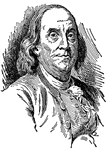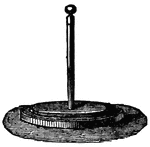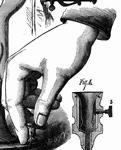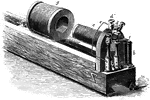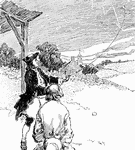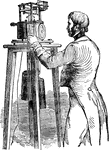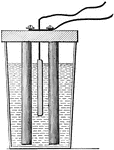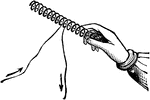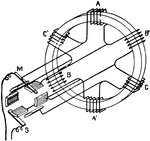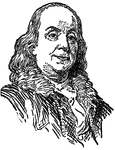
Dr. Benjamin Franklin
(1706-1790) United States diplomat, inventor, politician, and printer. Invented the Franklin stove,…
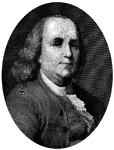
Dr. Benjamin Franklin
(1706-1790) United States diplomat, inventor, politician, and printer. Invented the Franklin stove,…
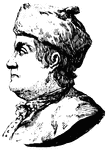
Dr. Benjamin Franklin
(1706-1790) United States diplomat, inventor, politician, and printer. Invented the Franklin stove,…

Ray
This singularly formed fish, the torpedo, has two electrical batteries-that is, machines for making…
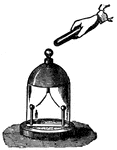
Electroscope
Apparatus for showing the presence of electricity without giving quantitative measurements.
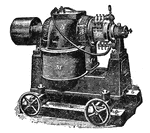
Dynamo
The dynamo machine generates electric currents by converting motive power into electricity through the…

System of Arc Lights
The System of Arc Lights is a device used to obtain electric light by conducting a current of electricity…

System of Incandescent Lights
The System of Incandescent Lights is a device in which electric light is obtained by conducting a current…
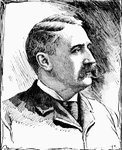
Charles F. Brush
"Charles F. Brush was an inventor, specifically in the field of electricity."—E. Benjamin Andrews…
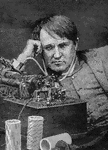
Thomas Alva Edison
"Thomas Alva Edison was born at Milan, Ohio, February 11, 1847, but the family soon after moved to Port…

Ampere-meter
"An instrument for measuring the strength of an electric current in amperes."-Whitney, 1902

Galvanic Battery
"Galvanism is the branch of electric science to which an experiment by Galvani gave birth. His wife,…

Double Tuberose
"Tuberose (Polianthus) is a genus of plants of the natural order Liliaceæ. The plant is in high…

Voltaic Pile
"Volta's arrangement for producing a current of electricity, consisting of a pile of alternate disks…
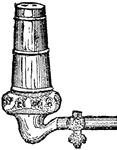
Gas-burner
That part of a gas fixture where the gas is burned as it escapes from one or more minute orifices.
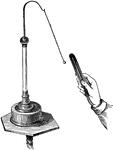
Demonstration of Static Electricity
A hand with bar demonstrating the attractive properties of static electricity.
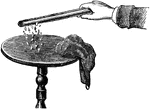
Demonstration of Static Electricity
A hand with a rod, demonstrating the attractive properties of static electricity.
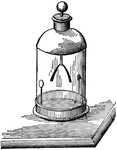
Electroscope
"The electroscope is an instrument for detecting and testing electrification. A metallic rod passes…
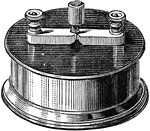
Condenser
"Condensers of a the flat type, consisting of tin-foil conductors separated by thin, flat dielectric…

Leyden Jar
"The most common and, for many purposes, the most convenient form of condenser is the Leyden jar. This…

Needle, compass
"Bring the two ends of the wire into contact, and thus close the circuit. The needle instantly flies…
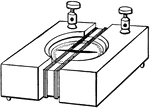
Galvanoscope
"Secure the two ends of the wire by double-pointed tacks. Place a small pocket compass upon the block…

Voltaic cell
"Just as a head of water supplies a hydraulic pressure that causes the liquid to flow through a pipe…
Electromagnet
"An electromagnet is a bar of iron magnetized by an electric current, substantial as just shown." —…

Electromagnet
"When an electromagnet is U-shaped, the coils around the two ends of the bent iron core are so wound…
Siemens armature
"Consists of a coil of wire wound in two broad grooves plowed on opposite sides of an iron cylinder."…
Drum armature
"The drum armature differs from the shuttle armature chiefly in that it employs many coils instead of…
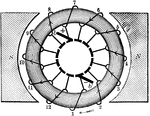
Commutator
"If the connections of the armature coils are reversed at the moment when the current in the coils is…
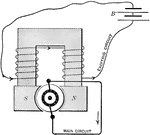
Seperately excited dynamo
"The electromagnet that supplies the flux of force must have a current to excite it. This current is…
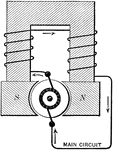
Series dynamo
"The electromagnet that supplies the flux of force must have a current to excite it. This current is…
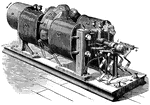
Brush dynamo
"A shaft runs through the machine from end to end, carrying a pulley, P, at one end, a commutator, c,…
Kinnersley electrical air-thermometer
"Various methods have been devised for measuring electrostatic quantity, one of the simplest of which…

Electric gas light
"Electric gas lighting is often effected by sparks from the interrupted circuit of a voltaic battery,…
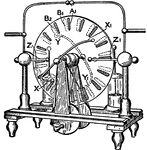
Wimshurst Electric Machine
"The essential parts of an ordinary Wimshurst machine, are two ordinary drums. On each plate are fixed…
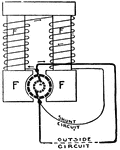
Dynamo
"The dynamo has its field mangets F F magnetized by means of a small current flowing around a shunt…
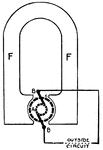
Magneto
"In a magneto the field magnets are permanently magnetized. The strength of the magnet field of a magneto…
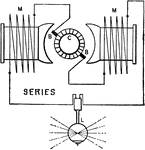
Series wound dynamo
"Series wound dynamo, used for series aarc lighting, and as a booster for increasing the pressure on…

Shunt dynamo
"The shunt wound dynamo differes from the series wound machine, in that an independent circuit is used…
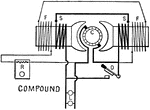
Compound wound dynamo
"Compound wound dynamo, used when better automatic regulation of voltage on constant pressure circuits…
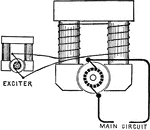
Seperately excited dynamo
"Separately excited dynamo. Current for field excitation is supplied by a second and smaller generator."…
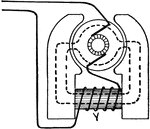
Bipolar field magnet
"Salient pole, bipolar field magnet with single coil wound around the yoke." — Hawkins, 1917
